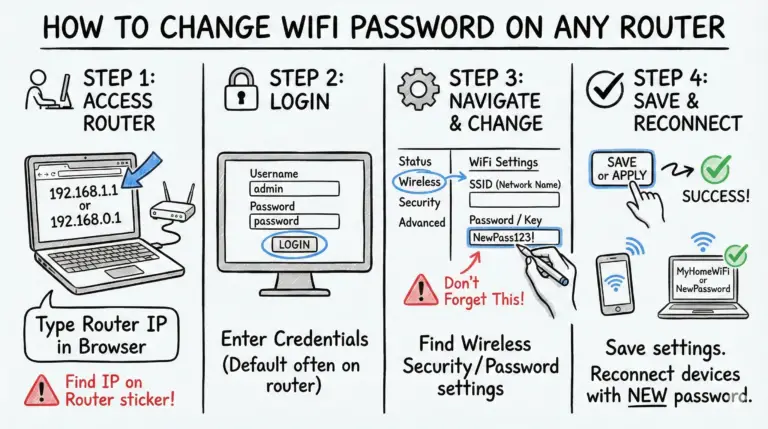Losing internet after resetting your modem? It’s usually a quick fix! Most often, it’s just a matter of waiting for your router to fully reboot or re-entering your default Wi-Fi password. If that doesn’t work, don’t worry – there are other easy solutions we’ll cover in this guide.
Make sure you complete the steps below before trying other things:
Wait for the Router to Reboot – After a reset, give your router up to 10 minutes to fully restart and restore the internet connection. If it was a factory reset, this time allows the router to clear its settings and reconnect properly.
Re-enter Wi-Fi Credentials – If you performed a factory reset, re-enter your default Wi-Fi username and password, as they will revert to what is printed on the router’s sticker.
Update SSID and Password: If you had previously customized your network’s SSID or password, you would need to reconfigure these settings using the modem’s administration interface.
Diagnose with Alternative Methods
- Try a Wired Connection: Connect a computer directly to the modem using an Ethernet cable. If the internet works via Ethernet but not Wi-Fi, the issue might be with the wireless signal.
- Eliminate Interference: Reduce wireless interference by turning off devices that could cause disruption, like microwaves or cordless phones. Also, changing the Wi-Fi channel on your router can help reduce interference from neighbors’ Wi-Fi networks.
Check all Cable Connections
One of the first things to check when you’ve lost internet after resetting your modem is the physical cable connections. Over time, cables can work themselves loose, become damaged, or degrade in performance.
Here’s what to look for:
- Ensure the power cable is securely plugged into both the modem and the wall outlet. If the outlet is connected to a switch, make sure it’s in the on position.
- Check the coaxial cable (for cable internet) or phone line (for DSL) running from the wall jack to your modem. These should be firmly hand-tightened – no need for tools. Look for any kinks, cuts, or excessive bending that could indicate damage.
- If you use a separate router, verify that the Ethernet cable between the modem and the router’s WAN port is fully inserted until it clicks into place. Inspect this cable for any signs of fraying or exposed wiring.
If you suspect any cable is faulty, the best way to test is to swap it out with a known working spare. Replacing cheap ethernet and coaxial cables is often an easy fix for mysterious connectivity problems.
🔌Power Cycle Your Modem and Router
If your cables seem fine, the next step is to power cycle your networking equipment. This clears out any temporary glitches and forces your devices to re-establish their connections.
Follow these steps in order:
- Unplug the power cord from your modem and remove any batteries if it has a backup.
- If you have a separate router, unplug its power cord as well.
- Wait at least 60 seconds. This gives time for the devices to fully discharge.
- Reconnect the power to your modem first. Wait until all the lights have turned on and it’s fully booted. This can take a few minutes.
- Now plug your router back in and give it a couple minutes to boot as well.
- Check if your internet connection has been restored on your devices.
Power cycling will resolve many common internet problems, so this is always a good early step to try.
☎️Contact Your Internet Service Provider
If you’ve checked your cables and power cycled your equipment to no avail, it’s time to get your Internet Service Provider (ISP) involved. They can run remote diagnostics and track down problems between the modem and their network that you can’t see on your end.
Start by checking your ISP’s website or mobile app for any reported service outages in your area. If there’s an outage, you’ll have to wait for the technicians to resolve it, but at least you’ll know it’s not an issue with your equipment.
If there are no outages, call your provider’s technical support number. They can pull up your account, “ping” your modem remotely, and walk you through further troubleshooting tailored to your specific situation and equipment.
Be prepared to provide your account number and answer some basic questions about the problem you’re experiencing and the self-troubleshooting you’ve already tried. If the phone support is unable to resolve your issue, they can send out a technician for an in-person evaluation.
🔄Update Router Firmware
Outdated router firmware can occasionally lead to conflicts and connectivity issues – especially after a reset. Depending on your router model, you may need to manually check for and install updates.
To update your firmware:
- Connect a computer to the router with an Ethernet cable. This ensures a stable connection even if WiFi isn’t working.
- Open a web browser and log in to your router’s admin interface. This is typically done by entering the router’s default gateway IP address – something like 192.168.0.1 or 192.168.1.1. Check your specific model’s documentation for the correct address and login credentials.
- Once logged in, locate the firmware update section. Download the newest firmware version from the manufacturer’s website to your computer.
- Upload the firmware file through the router’s interface and wait for it to install. The router will likely reboot during this process.
- Confirm the new firmware version number is displayed in the interface. Try connecting again to see if it resolved your problem.
Keep in mind some newer routers do support automatic updates which help avoid this type of issue. If yours has this option, consider enabling it for simpler maintenance going forward.
🛠️Reset Your Router to Factory Default Settings
If all else fails, you can try a factory reset of your router as a last resort. Be aware this will erase all of your router’s settings – including your network name (SSID), security passphrase, port forwarding rules, etc. Basically, it returns the router to the state it was in when you first took it out of the box.
Here’s how to reset most routers:
- Locate the small reset button on your router. It’s often on the back or underside.
- With the router powered on, use a paperclip or similar object to press and hold the reset button for 30 seconds.
- Release the button and wait a few minutes for the router to fully reset and reboot.
- Connect to the router using an Ethernet cable as you may need to set up the WiFi again from scratch.
- Open a web browser and access the router’s admin page using the default gateway address. Log in using the default username and password (often printed on the router itself).
- Reconfigure the router with your preferred settings, WiFi network info, and security. Apply the new settings and try connecting your devices again.
Keep any reference material that came with your router handy as you’ll need to consult it for model-specific instructions during this process.
🚀Consider Upgrading Your Modem and Router
Sometimes your connectivity woes may come down to simply having outdated hardware. If you’ve had the same equipment for many years, it may no longer be fully compatible with your ISP’s current network technology.
A few signs that it’s time to upgrade include:
- Your modem doesn’t support the latest DOCSIS standards (e.g. DOCSIS 3.0 or 3.1) which can limit your download speeds.
- Your router only has 802.11b/g/n WiFi. Newer 802.11ac and WiFi 6 routers offer much better range and performance.
- You’re paying your ISP a monthly rental fee for their equipment. Buying your own can save money in the long run.
- Your devices seem to outperform your network connection. Gigabit-capable devices will be limited by older networking hardware.
Contact your ISP to see if they offer any specials on new hardware or have a list of compatible modems and routers they recommend. Make sure to get equipment that matches your current internet plan’s speeds to avoid overpaying for features you can’t take advantage of.
Conclusion
Troubleshooting your internet connection after resetting a modem can be a multi-step process, but knowing where to start is half the battle. To recap, here are the key things to try:
- Check your cable connections for looseness or damage.
- Power cycle the modem and router to clear temporary issues.
- Contact your ISP to rule out outages or line problems.
- Update your router’s firmware to resolve software bugs.
- Factory reset the router as a last troubleshooting step.
- Consider upgrading your equipment if it’s old and outdated.
Remember to approach the problem methodically and be patient as you work through the steps. Don’t be afraid to reach out for help from your ISP or tech-savvy friends if you get stuck along the way.
Keep in mind that sometimes connectivity issues can be caused by reasons outside of your control – like damaged lines from a storm or problems with your provider’s infrastructure. In these cases, the only solution may be to wait for the ISP to resolve things on their end.
We hope this guide has given you a solid starting point for getting your internet connection back up and running. Drop us a comment if you have any other tips or tricks that have worked for you in the past!
- How to Configure a Secure Site-to-Site VPN on Cisco Firepower Complete Guide - December 3, 2025
- Jobs for Network Engineers: Roles, Skills & Pay - December 3, 2025
- How to Change WiFi Password on Any Router : The Last Guide You Need - December 1, 2025



